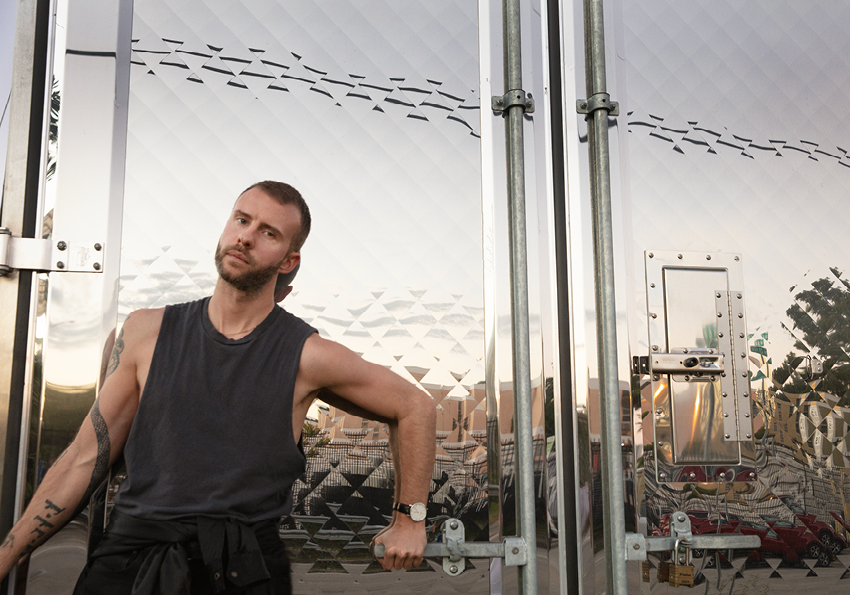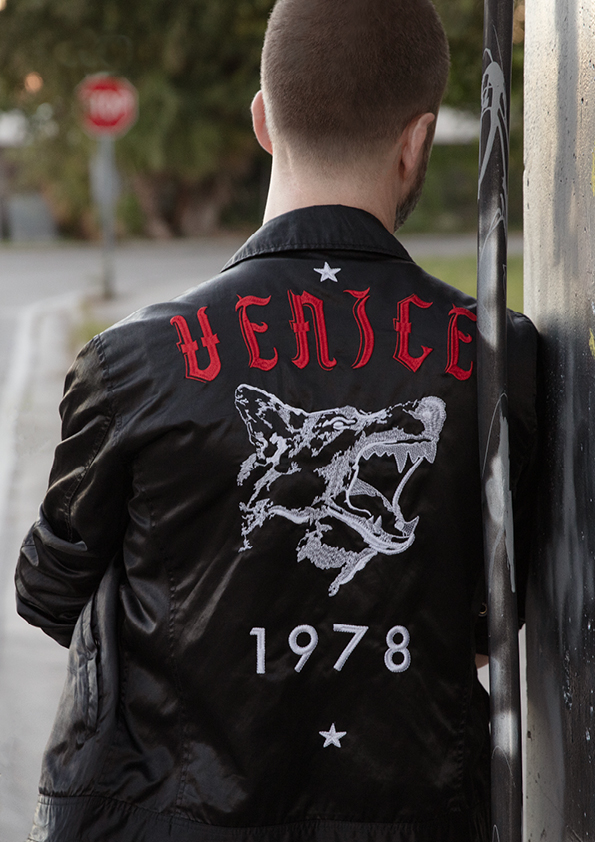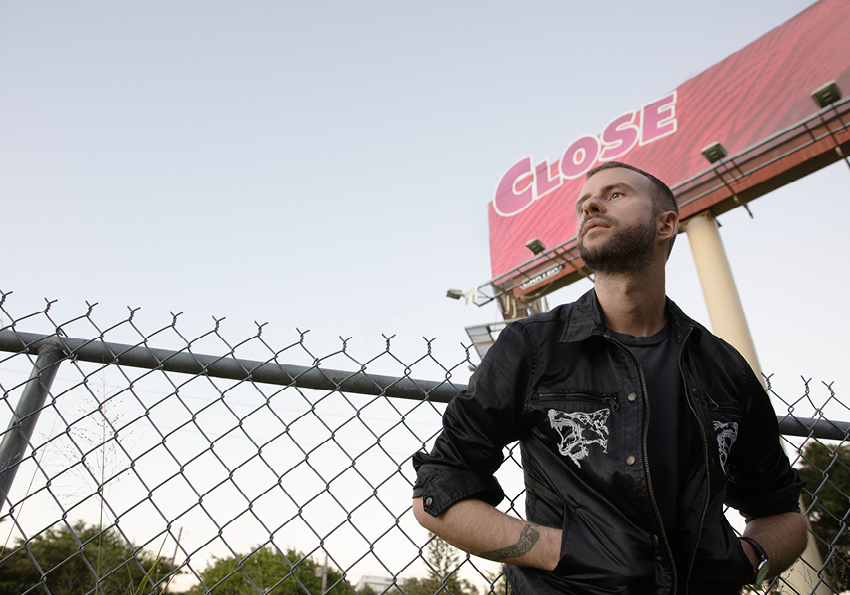Interview and portraits by Milan Vukmirovic

Scott Mabe’s work exists between the analog and the digital, the landscape and the figure. It is within the confines of this space, what we refer to as the in-between, where he finds a point of view that is ultimately queer. Born in Texas on a dairy farm to a Baptist preacher father and a schoolteacher mother, he was the youngest of six children. In his younger years, Scott began taking photographs of the rural landscape and the people who inhabited it. Using disposable Kodak cameras, he decided the trajectory of his career would be aligned with this passion – hence studying Photography and Art History at the University of North Texas. Shortly thereafter, Scott moved to New York City where he honed in on his digital photo manipulation skills. Fast forward to today, this has led to his current body of work, which is a reflection of and bastardized the rural landscape of his childhood. Documented in analog, you will discover his vast works including digital erotic images.
MV: How do you present yourself or define yourself to someone who doesn’t know you ?
SM: I would say that I am a ‘Photoshop nerd’ that makes digital collage work that involves analog photography.
MV: I fell in love with your work and I see you as an artist, but I have a feeling that you have a difficult time defining yourself as one. Is it because of your main and first job as a professional photo retoucher?
SM: That’s a good question. I’m just now starting to become comfortable defining myself as an artist, but probably similar to what you said: it’s something that’s been slowly building for so many years, and now it’s built enough to where I finally feel comfortable saying “oh yeah, I can do art.”.
MV: I did many things in my life and photography came late in my career and it took me time to call myself a photographer. I didn’t attend a formal school for it, and because of my lack of formal education, for a while I was questioning myself – after all I would never want to be seen as a ‘fraud.’ In your case, because you were an expert in your retouching world, how does it feel to have spread your wings and catapulted yourself to becoming a master in your own right?
SM: Yeah. I do like saying I’m a ‘Photoshop nerd’ just because – firstly, it’s really approachable and second of all, Photoshop became such a complete gateway for me to creatively express myself.
MV: But most Photoshop users or retouchers are not becoming artists.
SM: True. It’s a strange trajectory.
MV: Do you think there will be a moment where you could be ready to say I’m an artist and that’s it? Nothing else.
SM: That’s a goal. Wouldn’t that be nice? Yeah. I think with each passing year, I’m getting closer to that point. I mean the one thing that I’m very thankful for is that, with this body of work, I appreciate that other people love it. I didn’t think that it was possible that anyone would love it more than I do.
MV: When did you decide to create your own images and your own art – stepping outside of the box?
SM: Well, like years ago I started. I mean, I can’t remember what was the conscious choice to flip the script, but I started doing all kinds of pretty abstract digital collages where I would take images I found, whether that be erotic and hot shots from Tumblr or screenshots from porn. And then I would cut them out, making like solid color backgrounds and that’s how my collaging began. And I thought that was really cool, hence doing that for a while. And then one night I had 35 mm scans from photos I’d just taken from my parents’ place back home. As expected, lots of cattle and I decided to randomly put some of my naughty images on top of the cattle. And I was like, wait, this makes sense. Not only do I like what this is doing visually, it also creates a real conversation between analog photography and digital, online ephemera, putting it together. And I was like, I should keep doing this.

MV: Collage is usually cutting, mixing and putting together existing images. In your case you are using your own landscape photography and you are furthermore integrating existing pictures from porn or erotic magazines or books. So it’s more than just a nice ‘new cut’ composition; there’s an intention behind every movement. Not only do you make something beautiful, but you provoke a strong emotion for the viewer and that’s why your work is definitely artistic to me…
SM: That’s a rather interesting perspective. I mean, I do like the term Collage. Plus, the idea of creating collage as a medium provides the power to manipulate and also completely ignore boundary lines. To rebuild and create a narrative through a structure is amazing.
MV: You talk a lot about the technical aspect of your work. But what I love in your work is that the viewer sees just a strong emotional, often sexy, full complete , fascinating image in front of them.
SM: I mean maybe a more appropriate term could be just photography. After all that is kind of the end goal, right? What makes me most proud is when someone looks long, hard and deep and understands that the work is much larger than pieces on a paper – there is something major happening.
MV: How or where do you get inspired when you actually shoot the landscape that is the foundation/inlay of each of your works?
SM: To put words to that is quite an uphill battle. The ones that speak to me are those that are shot in my native Texas in the small town where I grew up. And that is a challenge as you can imagine. My upbringing as a homosexual who was unable to express that in any way, shape or form…well, for me to be able to return to that place is a struggle at times. However, when I press pause and reflect, my current homo-erotic energy provides me with a real sense of power in a way I was never able to when I actually lived there.
MV: When did this need of expressing eroticism begin?
SM: Being raised in a very religious and extremely repressed home, as an adult, I just would gravitate instantly to sexual imagery. It has a mystique. Actually, I recall when I was probably in junior high and I first saw the Fiona Apple ‘Criminal’ video – and I was like, oh, whatever this music video is doing is very sexual, very cool, and at the same time – very sad. It opened my eyes to whatever that was, it was what I wanted. That kind of got me into photography in the sense that, uh, I would get disposable cameras and try to take photos of my female friends in high school in a way that poorly mimicked that video. Looking back, sexuality and sensual imagery have always just been within me.
MV: The last decade with social media, platforms like Onlyfans, we have been subjected to sexyness and erotism everywhere. It seems rare to see a true artistic work. But yours is. And still, it has still a very strong and powerful sexual
immediate impact. Is your work similar to a sexual urge or an obsession?
SM: When I go to create these pieces there is a very deep urge which is very different from a sexual urge. I’m not sure at what point my sexual being stops and starts with my work. Also being sexual in some ways, to me it feels categorically different, but at the same time it has to interact with each other.
MV: You said that a lot of your landscape photographs were captured where you grew up in Texas. Most of those places are empty, or seem lifeless. I guess it’s done on purpose because it just reinforces the inclusion of sexual content afterwards ?
SM: Yes, it’s powerful and it feels like everything came full circle. It’s almost as if it gave me an added layer of power paired with reclaiming my youth…comparable to me getting in touch with my inner child and making peace. Before we started this, I was thinking about how I just gather all these seemingly random, mostly erotic photos that I connect and throw in an imaginary bag and save them for later use.

MV: Talk to us about Texas’ very American masculinity spirit and culture of horses, cowboys and cars..Think Richard Prince. How does that play into your style?
SM: I’ve had an obsession with cars, gas stations….I suppose it comes with the turf. I mean, that was just growing up in that culture. The people cared a lot about trucks, engines, gas, and activities like hanging out at gas stations.
MV: We talked yesterday about this testosterone culture in America. Everything bigger and shiny and cars and big trucks seem to be a penis extension for some American men ( laughs )
SM: Now. Yeah. However, I think most people that work on trucks would not agree with this. I think it’s quite gay like that, but you’re right. It’s very testosterone driven to me. It’s basically doing drag when you’re souping up trucks and cars to really show yourself in this larger in life way. I find it very theatrical like drag. And I think it’s very sexual, too.
MV: I was surprised when I actually ordered some prints of your artwork for my house. I discovered your art on instagram and I guess you create and work on a computer screen. Shockingly, I was expecting to see big, large prints so I want to understand why keep it small when it would be even stronger on a wall?
SM: I guess. I mean that’s always subject to change and maybe I will go bigger. For now, I like the idea of them existing in a small way because they start off more than anything as 35 millimeter photos that I take on a point and shoot. So to me, I still see them as just like these kind of almost casual photographs that I’m not making anymore. So in my mind they’ve always been kind of a smaller scale project. In this constantly evolving journey where I just like to keep growing and that’s the most affirming wonderful part of it is that this just keeps getting better and I keep getting more sure of myself, too.
MV: Do you imagine yourself living just from your art and stop being a professional retoucher ?
SM: Yes. That’s definitely the goal because if you had asked me that question even two years ago, I’d be like, I don’t know if I could ever see a way. But now it’s like, I finally have gotten to a point where I care about this more than anything else I’m doing. I’m very thankful that I’ve been able to keep myself afloat also through Photoshop, which I enjoy in its own way. But it is obviously what I’m passionate about and everything has kind of come together. So the once shy boy is now getting noticed and that’s how I define my worth nowadays.
MV: What is the end game? Are you waiting for galleries and clients to come to you? And it’s not something negative, but sometimes being shy, being scared or unsure is more challenging than when things just fall into your lap….and they come to you and say I want you…
SM: Sure. I mean, I’ve definitely put myself out there more and more definitely, which also comes with rejection. And that is fine. But I just find that my focus has always been to create and make the work. I think I’m getting to a point, which I kind of talked to you about yesterday and that is I would love to start getting a book together. That would be like a big goal for me. And to get more shows.
MV: We talk about a lot of movies, music and everything along those lines. So who are the people that have been very important to you that still influence you and your process?
SM: I cannot reiterate enough how much the Fiona Apple video for Criminal by Mark Romanek opened my world up to like a language that I guess I didn’t know existed. An amalgamation of melancholy and sexuality. It was the style of that video, which is all moving flash photography, and they have red eyes. I just thought about all of that and it blew me away. And then there is PJ Harvey the English singer and songwriter. Her 1995 ‘You Bring Me Love’ album I respected her Southern Gothic vives which is very much where I grew up.
MV: We have talked about David lynch which we are both fans of…
SM: What really gets me with David Lynch is what he does is what I am attempting to do with this body work. He has a power of world building, for example what he did with twin peaks, how he just created this entire world like a huge tapestry. It still blows me away what he was able to do there. And I even listen to a lot of his music when I’m working.
MV: Would you ever consider shooting your own models performing on your Texan land rather than collages?
SM: No, I just don’t think it would be the same body of work.Why it works is because these models and these images are found online. And of course, I want to celebrate the artists and the models. So anytime I can, I make sure I credit them. I like this idea where it’s like this is my analog photography and this is the world I’m in and then juxtapose that with these strange images that I found in this graveyard that is the internet.
.MV: Do you have a camera with you all the time ?
SM: All the time! Funnily enough, except on this trip. I oddly forgot it. The irony! Uh, yeah. It’s my little Yashika T4 and I love it. It’s been with me since 2016 and still works like a champ.
Thank you Scott. You are a champ to us, and at FFM, we believe in you and your work..
Scott Mabe Artwork
